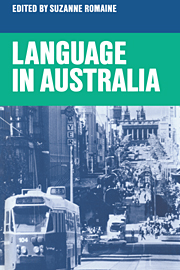Book contents
- Frontmatter
- Contents
- List of illustrations
- List of tables
- Notes on contributors
- Preface
- Acknowledgements
- Introduction
- Part I Aboriginal and Islander Languages
- Part II Pidgins and creoles
- Part III Transplanted languages other than English
- Part IV Varieties of Australian English
- Part V Public policy and social issues
- 23 National language policy and planning: migrant languages
- 24 Social class differences in the lexicon
- 25 Plain English: some sociolinguistic revelations
- References
- Index
23 - National language policy and planning: migrant languages
Published online by Cambridge University Press: 06 July 2010
- Frontmatter
- Contents
- List of illustrations
- List of tables
- Notes on contributors
- Preface
- Acknowledgements
- Introduction
- Part I Aboriginal and Islander Languages
- Part II Pidgins and creoles
- Part III Transplanted languages other than English
- Part IV Varieties of Australian English
- Part V Public policy and social issues
- 23 National language policy and planning: migrant languages
- 24 Social class differences in the lexicon
- 25 Plain English: some sociolinguistic revelations
- References
- Index
Summary
Introduction
Explicit concern for an official language policy in Australia is of recent origin. It has been a focus of attention for language professionals, policy makers and others for only the last decade. However, language policy has had a longer history in Australia, and during the learly part of this century, when previously multilingual elements in the Australian population were overwhelmed by an assertive Australian monolingualism (see Clyne, chapter 14 this volume, and Walsh, this volume), language policy was one of many methods of control of both Aboriginal and migrant populations (see Fesl 1988).
In the case of migrant languages, extensive controls over their institutionalisation evolved not only from general social antipathy towards alienness, but also more specific worries over alien languages and populations in wartime. Clyne (chapter 14, this volume) has summarised the pre-World War II restrictions on ‘foreign languages’ in school systems, school curriculum, and publishing of newspapers. Libraries stocked almost exclusively English language publications, and interpreting services were nonexistent. Following in the spirit of these policies, restrictions on the use of foreign languages in broadcasting were introduced in 1952.
These policies were based upon a particular view of the nature of (white) Australian society, and a belief that monolingualism was essential for social cohesion.
- Type
- Chapter
- Information
- Language in Australia , pp. 329 - 348Publisher: Cambridge University PressPrint publication year: 1991
- 6
- Cited by

